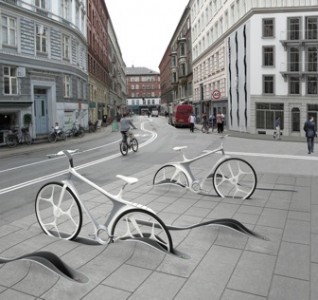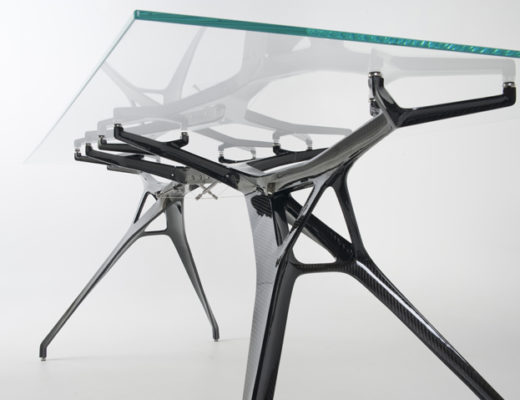Bike Share System – Rafaa Architecture and Design – Copenhagen
Designer: Rafaa Architecture and Design
Competition
This Bike Share System is more than just a transporting system. It deals not only with the problem of stocks and flows of people, but adds extra value to its user and to the city itself. We suggest that the Bike Share System becomes an integral part of the city. The bicycles should function as censors and inform the system about certain behaviors, so that the system can react according to the situation. To predict the performance of a system, the entities have to exchange information. An internet-based platform can analyze the different interests and could then manage possible conflicts. The bicycles are equipped with GPS and W-Lan, so they are connected to each order and can inform the system about their position and status. (Is a bike being used? Where is the bike and where is it moving to? Is there a reservation for the bike? etc.) Privacy protection is a matter that has to be taken into account in the process.
To increase the number of commuters traveling by bicycle from 37% to 50% by 2015, approx. 25.000 bicycles have to be integrated into the urban fabric; these bikes will need at least 20.000 m2 of storage space. We see a high risk of overloading the squares, streets and stations of Copenhagen. Therefore, our focus is to reduce the „visual pollution “wherever possible. At the same time, easy accessibility as well as the system’s visual presence has to be maintained (hide & show policy). The following proposal distinguishes between three different trajectory scales: S, M and L.
Bike (Scale S)
Today, the success of a system is not only based on its usefulness and benefits, it has to be fashionable, too. The outdated belief that you have to own an object to be able to use it leads to a kind of „consumption fetishism“. We think that this phenomenon can help us change the users’ habits. Our design philosophy is based on the belief that there are unspoken design values such as an excellent customer service. Not only must the handling of the Bike Sharing System be easy, but people have to be able to enjoy the whole experience from beginning to end. Even though every bicycle looks the same, it somehow becomes your rolling home every morning.
The bike combines usefulness with simple, modern elegance. Contrary to well known examples, it is neither a colorful toy nor a good, old, bulky bicycle. It will help to convey the positive and innovative image of Copenhagen, thus creating a sense of identity. The bike has to satisfy an important criterion to make both Copenhagener and tourists use it: It has to be better than their own bike! Great importance has been attached to user friendliness and innovation.
The bike has a computer including a display with integrated GPS and WLAN. It is equipped with a supporting electric motor and a 26V lithium battery (E-bike) to make it suitable for short and long distances up to 15km. The battery has a range of max. 50km and is recharged at the stations.
The lightweight aluminum frame is made of one piece, thus enabling an easy wiring inside. Most of the components are integrated into the frame or the wheel to prevent theft and damage. The LED lighting, for example, cannot be dismounted and drum brakes, generator and 8-speed gear are integrated into the hub. The inner part of the frame is made of carbon reinforced plastic with integrated LED lighting. It can be demounted for main-tenance. The bike is designed as “righty” respectively “lefty”, thus allowing an easy exchange of the wheels. The tandem function allows two bikes to be attached together at the axle (see tandem function). Since the cost of production is higher, safety precautions have to be taken. A registration respectively a credit or Maestro card is necessary to release the bike from the station. The card will only be charged in case of theft or damage. The GPS also records when the bike is taken outside of the city limits; if necessary, it can lock the bike by way of the electric drive.
How to use a bike?
To use a bike, you have to register in the internet or insert a credit or Maestro card into the bike’s handle bar and log in (see 1). The first 30 minutes are free; after that, 5 DKK per 30 minutes will be charged. The fee per hour rises proportionally so that the bikes stay in circulation. There are stations everywhere in Copenhagen’s city center (max. distance 300 meters). At all times, you can find out in the internet how many bikes are available at which stations. Commuters will be able to profit from a text message service informing them about available bikes. Train passengers will have the possibility to make a reservation 30 minutes in advance. By using the Bike Share System, you will get credit for other public transportation or discounts for various cultural events. After you have registered your personal settings into the system, they will be saved and displayed when logging in (see 2). In the menu Quick Start, the user will be able to choose from different options such as tourist or commuter (see 3). In My Menu, you can access music, audio news, DSB’s timetable or the bike settings (see 4). You will also find a navigation system with various saved destinations; this is particularly useful for tourists (see 5). For safety reasons, the image of the traffic captured by the camera in the saddle is displayed during the ride (see 6).
Small station
The stations are in-ground to reduce visual pollution. With it, we pursue the strategy to interweave the already existing urban fabric, grown over the years, with the new elements. The stations will become an integral part of reducing the pile of bikes. The bikes are shoved backwards into the ground and then locked. The batteries are charged and information gets exchanged via the plug-in. Thanks to the card reader integrated into the handle bar, there is no need for the usual check-in machine.
Construction
A pre-fabricated metal trough with all necessary plugs is built into the existing paving and subsequently re-covered with paving stones. The metal trough has a lateral slide rail making logging in easier. It also has a metal belt pushing the pedals into a horizontal position. The module can work with all kinds of surfaces. A small blinking light signals the charging state of the batteries or if there is a reservation for the particular.
- Bike Share System – Rafaa Architecture and Design – Copenhagen
- Bike Share System – Rafaa Architecture and Design – Copenhagen
- Bike Share System – Rafaa Architecture and Design – Copenhagen
- Bike Share System – Rafaa Architecture and Design – Copenhagen
- Bike Share System – Rafaa Architecture and Design – Copenhagen
- Bike Share System – Rafaa Architecture and Design – Copenhagen
- Bike Share System – Rafaa Architecture and Design – Copenhagen
- Bike Share System – Rafaa Architecture and Design – Copenhagen
- Bike Share System – Rafaa Architecture and Design – Copenhagen















No Comments